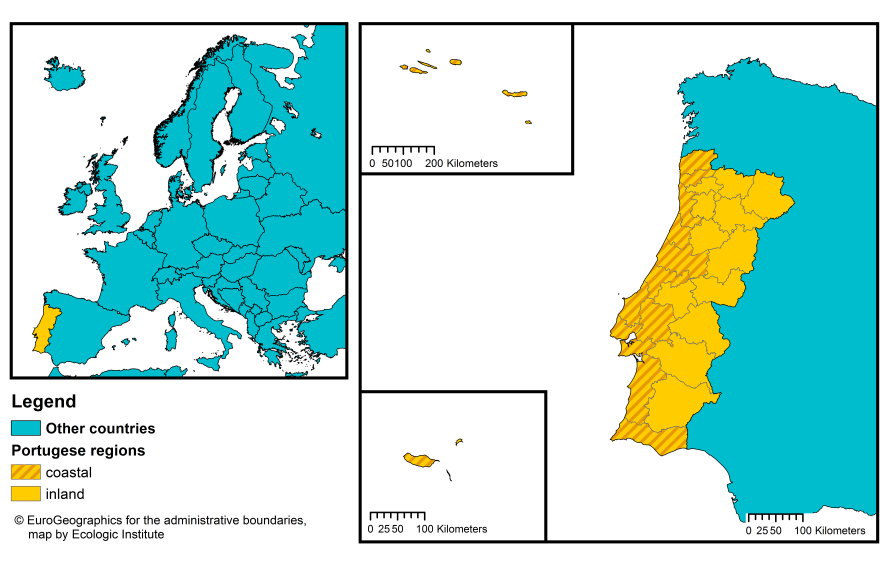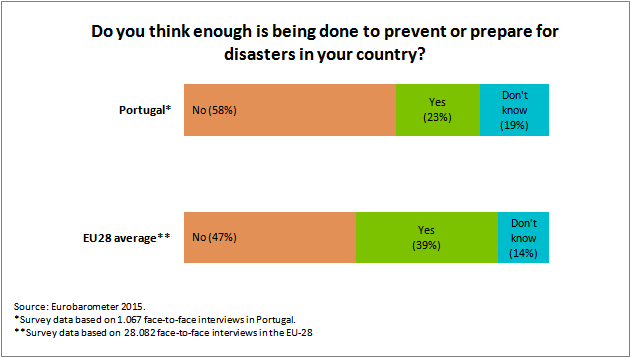Portugal has a coastline on the Atlantic Ocean. Around 85 % of the population (8.773.777 inhabitants) live in coastal regions1, as compared with the EU-28 average of 42 % (Eurostat, 2015).2 14 of Portugal's 28 intermunicipal entities (Entidades Intermunicipais) and 2 autonomous regions (Regiões Autónomas) are coastal (see Figure 1).
Figure 1: Map of administrative regions in Portugal at NUTS-3 level3

Portugal is an asymmetrical regionalised State: its governance regime is divided between central government (NUTS 1,2 and 3 level), Autonomous Regions and local level (LAU 1 and 2 level).
Portugal has five regions (NUTS-2 level), run by Coordination and Regional Development Committees (CCDRs). These include a board, monitoring committee and regional council, none of which is directly elected. Each CCDR has a President, appointed by the central government every three years. Sub-regions (NUTS-3 level) have no administrative significance in Portugal
At local level, both municipal (LAU-1) and parish (LAU-2) administrators are directly elected. They are responsible for the management of issues such as environment, public works urban planning and housing.
The two Autonomous Regions (Madeira and the Azores) have their own political and administrative statutes. They have extensive legislative powers and define their own policy, except for the field of foreign policy and defence and internal security, which are the responsibility of the central government.
TABLE 1: OVERVIEW OF TERRITORIAL DIVISIONS IN PORTUGAL USING NOMENCLATURE OF TERRITORIAL UNITS FOR STATISTICS (NUTS) and LOCAL ADMINISTRATIVE UNITS FOR STATISTICS (LAU). SOURCE: GADM database, version 2.8, 2015 and Euro Geographics, 2013
| NUTS level | Name | Total units | Coastal units |
|---|---|---|---|
| NUTS 1 | Mainland + Autonomous regions (Continente + Regiões Autónomas) | 3 | 3 |
| NUTS 2 | Regions + Autonomous regions (Regiões + Regiões Autónomas) |
7 (5+2) |
7 |
| NUTS 3 |
Intermunicipal entities (Intermunicipal Communities + Metropolitan Areas) + Autonomous Regions (Entidades Intermunicipais (Comunidades Intermunicipais + Áreas Metropolitanas) + Regiões Autónomas) |
30 (28+2) |
14 |
| LAU 1 | Municipalities (Concelhos - Munícipios) | 308 | 164 |
| LAU 2 | Civil parishes (Freguesias) | 3091 | 2000 |
GOVERNANCE OF COASTAL ZONES AND DISASTER RISK
Coastal protection and management
On the Portuguese mainland, coastal protection and management is primarily a national level task for which the Ministry for Environment is the responsible authority, the Port Administrations and the Ministry of Defence are responsible. The low level of participation in public decision-making is a well-documented problem in several policy fields in Portugal especially on topics of environmental controversy and including the management of coastal erosion (Basto and Centemeri, 2014). The Portuguese Environmental Agency (APA) is responsible for coastal defence works with a central branch in Lisbon and five branches corresponding to each of Portugal’s Regional Hydrographic Regions.
Portugal does not have legislation specifically on ICM, which s is addressed through spatial planning legislation. In Portugal, national legislation calls for the preparation of Coastal Zone Management Plans as part of the spatial planning system. The National Strategy for Integrated Coastal Zone Management provides overall policy direction for coastal management, and is coordinated with the National Strategy for Adaptation to Climate Change
Until 2016, the coastal zone has been covered by nine Coastal Zone Spatial Plans (POOCs). The development of the plans was supervised by the Water Institute INAG (and in protected areas by the Nature and Biodiversity Conservation Institute). These plans were superimposed over local territorial management plans (PDM) meaning that when the POOCs came into force, unsuitable areas had already been urbanized or construction permits already issued (Schmidt et al., 2013). On the other hand, efforts to integrate coastal plans with sectorial and regional plans under the National Programme for Territorial Management Policies (PNPOT) came only after the POOCs were issued. In practical terms, this has resulted in a lack of integration between coastal zone plans and territorial management policies (Basto and Centemeri, 2014). The POOCs have been described as complying with international norms rather than providing an effective preventive or precautionary approach to environmental problems (Ibid.). At the time of writing (February 2017) the POOCs are in the process of being replaced by POCs (Coastal Zone Programmes) that will cover five coastal zones which will correspond with Portugal’s Regional Hydrographic Regions.
Flood risk management
The EU Floods Directive 2007/60/EU is implemented by the Ministry of Environment and Water, through its eight River Basin Directorates via the 2010 Water Act. Thus far, Portugal has conducted its preliminary flood risk assessment (December 2011). Despite the extent of its coastal territory (more than double the EU average), Portugal did not produce maps for sea water flooding as part of its flood hazard and risk maps at the time of reporting in 2014. Maps for the autonomous region of the Azores were produced, but not for Madeira. Furthermore impacts of coastal protection/defences or climate change were also not considered at that time. Flood risk management plans (2015) are available for seven hydrographic regions. (For details of Floods Directive implementation in Portugal and other EU Member States, please read the RISC-Kit comparative assessment of Member State implementation of the Floods Directive.)

Disaster risk reduction
The civil protection system is headed by the National Authority for Civil Protection which is controlled by the Prime Minister and the Ministry of Interior. Inter-ministerial and inter-agency coordination is ensured by the National Coordination Centre. The National Coordination Centre coordinates the Integrated System for Relief and Protection Operations which sets out rules and procedures to ensure effective cooperation at the operational level.
The first point of action in the case of an emergency is at local or district level. In case the emergency cannot be managed at this level, the National Authority activates the National Coordination Centre and National Command for Relief Operations to coordinate activities. Other organizations can be involved in the emergency response depending on the disaster type.
At regional (district) level the civil governors are responsible for the activation of emergency civil protection (including prevention, aid, assistance and recovery).The National Authority also appoints the heads of several bodies (one each per district) tasked with civil protection at regional level: the District Commands for Relief Operations, the District Civil Protection Commissions (political coordination) and the District Coordination Centres (operational coordination). At the local (municipal) level, mayors have competence for these activities and responsibilities are part of the mayoral duties and are carried out by the Municipal Services for Civil Protection (one per municipality).
While civil protection appears well-defined and structured, there is no general notion of disaster risk reduction (DRR) in Portugal. Disaster risk reduction (DRR) policies are conceived and implemented through a complex net of organisations. Although DRR activities can be decided at national level, e.g. at the APA (Agência Portuguesa do Ambiente) in Lisbon or at a regional level (APA – Algarve), they are usually implemented at the local level. Moreover, DRR plans operate on a basis that is highly site dependent. However, even at a local level, risk communication is a top-down process that is generally undisputed by the public, meaning it is reduced to mere “risk information” (Basto and Centemeri, 2014).
There is also no policy devoted to coastal DRR. Risk reduction measures are included in the Coastal Zone Spatial Plans (POOCs) and are being integrated in the POCs currently (February 2017) being developed and rolled out (see 'Coastal protection and management' above). They are also included in the Portuguese programme on Integrated Operations towards the Renewal and Enhancement of the Coastal Zone, in the strategic plans of the coastal agencies (POLIS Litoral), as well as in conservation plans and other documents.
The following section examines some of the specific policies for coastal management and disaster risk reduction in Portugal.
TABLE 2: OVERVIEW OF KEY POLICIES FOR COASTAL MANAGEMENT AND DISASTER RISK REDUCTION IN PORTUGAL
| Type | Policy | Description |
|---|---|---|
| Civil protection | General Law for Civil Protection (Law 27/2006) |
|
| National Civil Protection Authority Law (Law-Decree 75/2007) |
|
|
| Law Decree establishing the Integrated System for Relief and Protection Operations (SIOPS) (Law-Decree 134/2006) |
|
|
| Law defining the organisation of Civil Protection at local level (Law 65/2007) |
|
|
| Coastal management | Coastal Zone Spatial Plans (POOCs) |
|
|
(POLIS Litoral) |
The main objectives are to:
|
FOOTNOTES
1 AN EU COASTAL REGION IS A STATISTICAL REGION OF THE EUROPEAN UNION, AT NUTS LEVEL 3, DEFINED ACCORDING TO ONE OF THE FOLLOWING THREE CRITERIA: 1. THE REGION HAS A SEA BORDER;: 2. THE REGION HAS MORE THAN HALF OF ITS POPULATION WITHIN 50 KM FROM THE SEA; 3. THE REGION IS HAMBURG. (THE GERMAN NUTS 3 REGION OF HAMBURG DOES NOT CORRESPOND TO THE ABOVE 2 CRITERIA BUT HAS BEEN ADDED TO THE LIST OF EU COASTAL REGIONS DUE TO ITS STRONG MARITIME INFLUENCE). SOURCE: HTTP://EC.EUROPA.EU/EUROSTAT/WEB/MARITIME-POLICY-INDICATORS/METHODOLOGY, LAST CHECKED: 14.09.16
2 ONLY TERRITORIES WITHIN THE EUROPEAN CONTINENT ARE INCLUDED EUROSTAT LIST OF COASTAL REGIONS (COAS_NUTS3.XLSX), RECEIVED ON 15.09.2016, COMBINED WITH EUROSTAT POPULATION DATA FOR NUTS-3 REGIONS [DEMO_R_PJANAGGR3], LAST UPDATED ON 07.09.2016
3 NOMENCLATURE OF TERRITORIAL UNITS FOR STATISTICS
REFERENCES
Basto, E., and Centemeri, L. (2014). The Communication of the Risk of Coastal Erosion in Portugal: A Global Problem, A Local Trouble. ESSACHESS- Journal for Communication Studies, Vol. 7, No 1(13), 2014. https://ssrn.com/abstract=2481827
BRUNEAU, T.C., Jalali, C., Colino, C. (COORDINATOR) 2016. SUSTAINABLE GOVERNANCE INDICATORS: PORTUGAL REPORT. BERTELSMANN STIFTUNG. HTTP://WWW.SGI-NETWORK.ORG/DOCS/2016/COUNTRY/SGI2016_PORTUGAL.PDF
EUROBAROMETER 2015. SPECIAL EUROBAROMETER 433: CIVIL PROTECTION HTTP://EC.EUROPA.EU/COMMFRONTOFFICE/PUBLICOPINION/INDEX.CFM/SURVEY/GETSURVEYDETAIL/INSTRUMENTS/SPECIAL/SURVEYKY/2067
PRC/MRAG. (2009). FINAL REPORT “THE ECONOMICS OF CLIMATE CHANGE ADAPTATION IN EU COASTAL AREAS”. PORTUGAL COUNTRY FICHE. HTTPS://EC.EUROPA.EU/MARITIMEAFFAIRS/SITES/MARITIMEAFFAIRS/FILES/DOCS/BODY/PORTUGAL_CLIMATE_CHANGE_EN.PDF
Schmidt, L., Prista, P., Saraiva, T., O’Riordan, T., & Gomes, C. (2013). Adapting governance for coastal change in Portugal. Land Use Policy. 31, 314-325.
